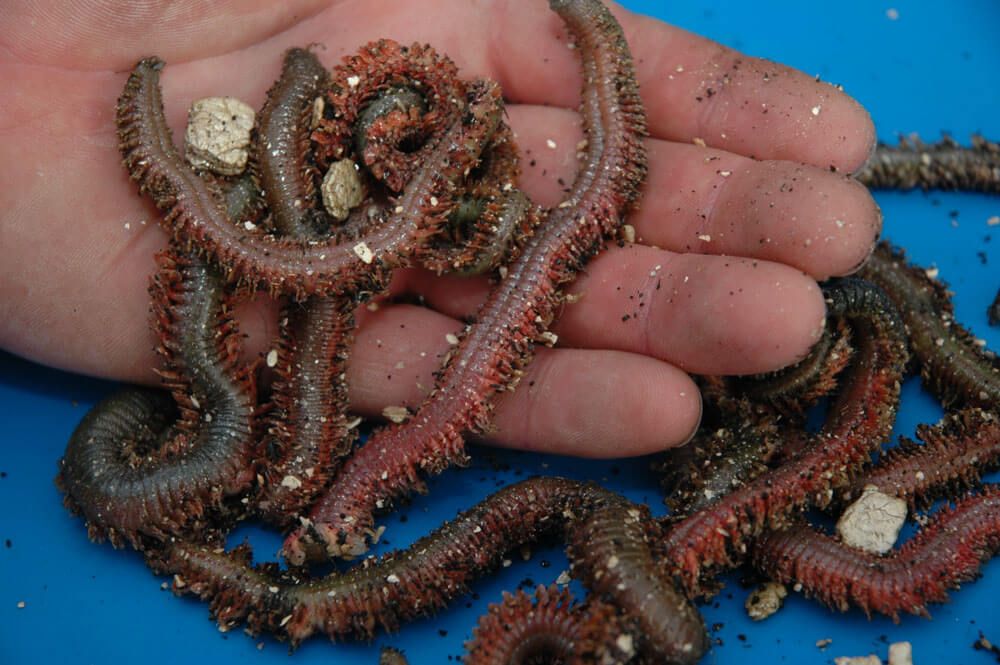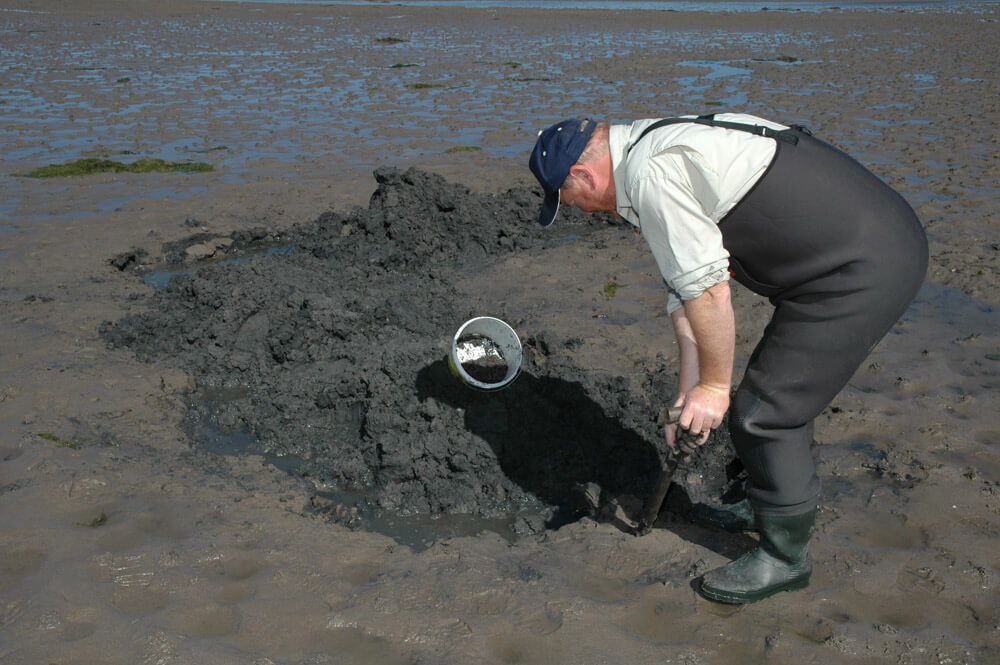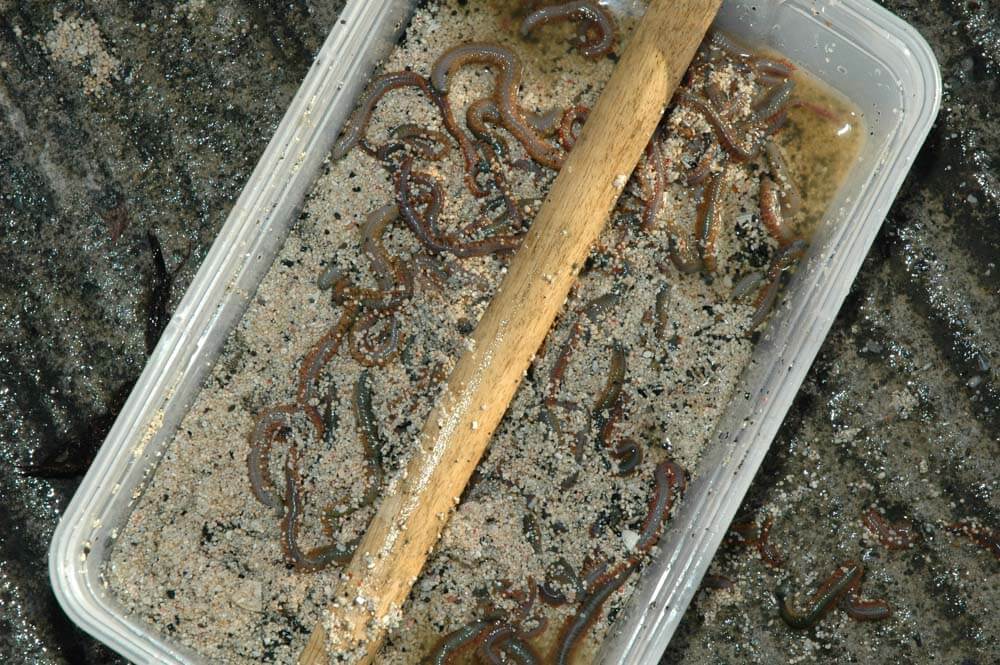It's almost impossible to mistake the king rag for any other marine ragworm due to it's sheer size. Juveniles are a minimum 3", with the average worm between 6 and 9" long. Much larger worms to 18" are not uncommon, and specimens to 24" can be found in North Wales and occasionally elsewhere. There are records of king rag growing to 36" and having the diameter of a man's thumb!
The colouration covers a wide range. Mainly mid green, but with a dark purple iridescence along the back. Many worms take on an orange tinge and even vermilion when taken from their burrows. The belly carries a pinker tint.
The head has four long antennae or feelers either side which the rag uses to find food. Two large black pincers called Chitinous jaws are housed in the mouth. These are to stab and hold onto prey that the rag comes across and are powerful enough to penetrate the skin on the fingers of the digger. Along the sides of the body are locomotory feet that aid swimming, are used to circulate water to retain freshness, and to bring food to the worm via the water drawn into the burrow.

LOCATION
King rag favour an almost estuarine environment with a near passing source of well diluted freshwater such as the mouth areas of smaller estuaries and along the near seaward banks of major ones. This born out by the top areas being parts of Hampshire, along the Bristol Channel, the Menai Straits in North Wales and some of the West Scottish Sea lochs, all having that element of freshwater content.
The adult worms seek out areas of mud and silt laying over and amongst broken rocky ground and are sometimes found in split bed rock and weed. Mussel beds anchored over mud and rock ground at the heads of estuaries hold rag, and so can fine graded gravel banks alongside cleaner sand, though these worms tend to be the smaller juveniles.
COLLECTION
Almost as much fun as the fishing, but messy! It's rare nowadays, to be able to trench king rag like you can blow lug. In years gone by you could, but heavy digging pressures over the past two decades and also pollution has reduced and scattered the worm numbers.
You need a strong, flat tined potato fork for digging rag. It's wise to modify the right fork by eliminating the wooden handle and having a metal shaft welded direct to the fork itself for strength. You'll be using the fork as much as a lever as you will as a digging instrument.
The technique is to walk backwards slowly over the mud patches amongst the rocks looking for a small, circular hole up to .25" in diameter in the mud's surface that suddenly floods and overflows with water. This indicates where a rag burrow is and often has a small circle of blown out mud around it. As your weight passes over the burrow, the worm starts to wriggle deeper into it's lair and forces water out through the blow hole.
Start digging as deep as you can right over the hole, then slowly widen the digging circle with each fork full around the hole until you discover the worm. Rag can be as much as 2' from the hole. The depth you dig may only be a few inches in heavy ground, but you'll still turn out the worm.

It's less reliable, and you need a quick hand, but it's worth turning over flat stones that lay amongst mud etc. Rag can sometimes be found laying flat underneath these stones, fully exposed, when their burrow has touched the stone and they've been forced to dig along the surface for a way. If a worm makes it part way back into the burrow, but you get a grip on it, just keep up a steady pressure without breaking the worm and it will slowly release it's grip and come free.
TIDES
Tides govern the collection of rag. Rag tend to live from about mid tide zone to below the lowest spring tide water line. Also, because of the heavy digging pressure, it makes sense to try to work the ground that uncovers infrequently only on the bigger tides where the worm beds have been least disturbed.
Rag become fairly dormant on the last of the ebb tide and are deeper in the burrows. As soon as the new flood gets underway their activity increases and they start to move and hunt bringing them closer to the surface. Digging on the ebb is rarely as successful as digging with the tide on your heels.
WEATHER EFFECTS
Frosty weather puts the worms deep, but humid nights keep them surface working and easier to dig.
Rag resident close to and in estuary mouths can be put down deeper into their holes by continual heavy floodwater pushing through the estuary. Likewise, digging during actual heavy rain also makes you have to work harder to fill the bait bucket.
Experienced rag diggers prefer to dig during the dark hours with a not too bright headlight as the rag are far more active in the dark hours and close to the surface.
STORAGE
Correct storage starts at the digging stage. As you dig, separate any damaged worm from the whole ones. Their blood is very toxic and will quickly kill off the rest.
Vermiculite chips from a builders supplier or a bed of almost dry sand placed in a plastic ice cream container with air holes in the lid is good for longer term storage in a bait fridge set at about 40 degrees Fahrenheit. You can wrap the worms en mass in numbers of 6 large worms or over a dozen smaller ones in several sheets of newspaper and then into the fridge, but you'll need to change the paper daily.
Winter and summer it pays to transport your worms as stored in the fridge to the fishing station in a proper cool box with ice packs added. But keep the worms fully insulated from actually touching the ice packs with a sheet of polystyrene placing the packs above this and the worms.

BUYING TIPS
When buying rag from a tackle shop it's worth asking to see the rag, don't just take the packets that are given to you. You're looking for lively worms that wriggle and snake with energy. Dormant worms may have been kept at too low a temperature causing them to go comatose, but mostly this is a sign that they are past their best and about to expire.
Also check that their skins have not started to go crinkly, another sign that they have been kept long term and are not in the best of health.
Think about the size of the worm that's best suited to the species you intend to target. Generally, you want the smaller 3-6" worms for smaller species like plaice, dogfish, codling etc, but take the big 8" plus worms when after bass, stingray and cod.
The colouration covers a wide range. Mainly mid green, but with a dark purple iridescence along the back. Many worms take on an orange tinge and even vermilion when taken from their burrows. The belly carries a pinker tint.
The head has four long antennae or feelers either side which the rag uses to find food. Two large black pincers called Chitinous jaws are housed in the mouth. These are to stab and hold onto prey that the rag comes across and are powerful enough to penetrate the skin on the fingers of the digger. Along the sides of the body are locomotory feet that aid swimming, are used to circulate water to retain freshness, and to bring food to the worm via the water drawn into the burrow.

LOCATION
King rag favour an almost estuarine environment with a near passing source of well diluted freshwater such as the mouth areas of smaller estuaries and along the near seaward banks of major ones. This born out by the top areas being parts of Hampshire, along the Bristol Channel, the Menai Straits in North Wales and some of the West Scottish Sea lochs, all having that element of freshwater content.
The adult worms seek out areas of mud and silt laying over and amongst broken rocky ground and are sometimes found in split bed rock and weed. Mussel beds anchored over mud and rock ground at the heads of estuaries hold rag, and so can fine graded gravel banks alongside cleaner sand, though these worms tend to be the smaller juveniles.
COLLECTION
Almost as much fun as the fishing, but messy! It's rare nowadays, to be able to trench king rag like you can blow lug. In years gone by you could, but heavy digging pressures over the past two decades and also pollution has reduced and scattered the worm numbers.
You need a strong, flat tined potato fork for digging rag. It's wise to modify the right fork by eliminating the wooden handle and having a metal shaft welded direct to the fork itself for strength. You'll be using the fork as much as a lever as you will as a digging instrument.
The technique is to walk backwards slowly over the mud patches amongst the rocks looking for a small, circular hole up to .25" in diameter in the mud's surface that suddenly floods and overflows with water. This indicates where a rag burrow is and often has a small circle of blown out mud around it. As your weight passes over the burrow, the worm starts to wriggle deeper into it's lair and forces water out through the blow hole.
Start digging as deep as you can right over the hole, then slowly widen the digging circle with each fork full around the hole until you discover the worm. Rag can be as much as 2' from the hole. The depth you dig may only be a few inches in heavy ground, but you'll still turn out the worm.

It's less reliable, and you need a quick hand, but it's worth turning over flat stones that lay amongst mud etc. Rag can sometimes be found laying flat underneath these stones, fully exposed, when their burrow has touched the stone and they've been forced to dig along the surface for a way. If a worm makes it part way back into the burrow, but you get a grip on it, just keep up a steady pressure without breaking the worm and it will slowly release it's grip and come free.
TIDES
Tides govern the collection of rag. Rag tend to live from about mid tide zone to below the lowest spring tide water line. Also, because of the heavy digging pressure, it makes sense to try to work the ground that uncovers infrequently only on the bigger tides where the worm beds have been least disturbed.
Rag become fairly dormant on the last of the ebb tide and are deeper in the burrows. As soon as the new flood gets underway their activity increases and they start to move and hunt bringing them closer to the surface. Digging on the ebb is rarely as successful as digging with the tide on your heels.
WEATHER EFFECTS
Frosty weather puts the worms deep, but humid nights keep them surface working and easier to dig.
Rag resident close to and in estuary mouths can be put down deeper into their holes by continual heavy floodwater pushing through the estuary. Likewise, digging during actual heavy rain also makes you have to work harder to fill the bait bucket.
Experienced rag diggers prefer to dig during the dark hours with a not too bright headlight as the rag are far more active in the dark hours and close to the surface.
STORAGE
Correct storage starts at the digging stage. As you dig, separate any damaged worm from the whole ones. Their blood is very toxic and will quickly kill off the rest.
Vermiculite chips from a builders supplier or a bed of almost dry sand placed in a plastic ice cream container with air holes in the lid is good for longer term storage in a bait fridge set at about 40 degrees Fahrenheit. You can wrap the worms en mass in numbers of 6 large worms or over a dozen smaller ones in several sheets of newspaper and then into the fridge, but you'll need to change the paper daily.
Winter and summer it pays to transport your worms as stored in the fridge to the fishing station in a proper cool box with ice packs added. But keep the worms fully insulated from actually touching the ice packs with a sheet of polystyrene placing the packs above this and the worms.

BUYING TIPS
When buying rag from a tackle shop it's worth asking to see the rag, don't just take the packets that are given to you. You're looking for lively worms that wriggle and snake with energy. Dormant worms may have been kept at too low a temperature causing them to go comatose, but mostly this is a sign that they are past their best and about to expire.
Also check that their skins have not started to go crinkly, another sign that they have been kept long term and are not in the best of health.
Think about the size of the worm that's best suited to the species you intend to target. Generally, you want the smaller 3-6" worms for smaller species like plaice, dogfish, codling etc, but take the big 8" plus worms when after bass, stingray and cod.

